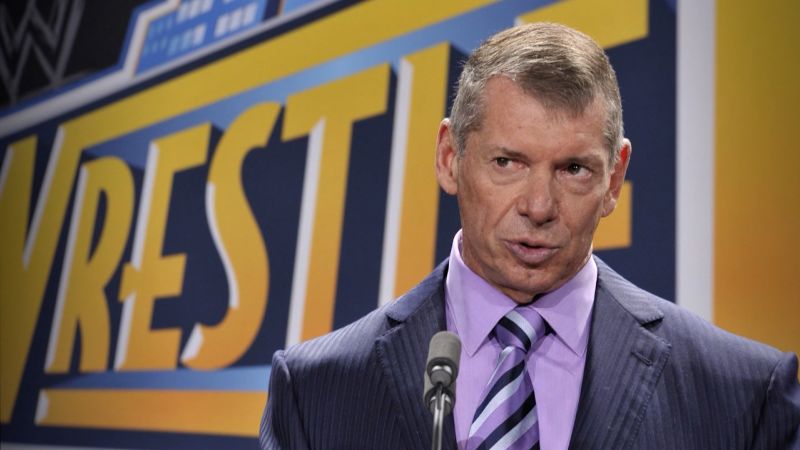Washington
CNN
—
Professional wrestling is known for its outlandish, dramatic stories that have captivated generations. It’s an athletic soap opera built on emotional drama with wrestlers sometimes scheming in the background for months only to make their move at the opportune moment, drawing crazed reactions from arenas packed with fans who have followed every beat.
But the real-life saga playing out in World Wrestling Entertainment’s corporate office over the last several weeks surpasses even what most of what those performers and their backstage colleagues could dream up.
Vince McMahon, the longtime force behind WWE at the corporate and creative levels, made a shocking return to the company on January 10, nearly six months after announcing his retirement. McMahon was alleged to have used company funds to pay millions to multiple women in order to cover up infidelity and allegations of sexual misconduct.
But over a series of just a few days last week, McMahon engineered his return to the company’s board of directors, reshaped it by forcing out some members, replaced them with his own allies, and used that new boardroom power to install himself in his old job as executive chairman. His own daughter – the heir apparent to the company who had appeared groomed to take the job for years – resigned.
The stunning and swift developments have the wrestling world reeling, with rumors of a sale burning up Wrestling Twitter and people inside and outside the company wondering what it all means for the future of WWE and professional wrestling itself.
In July, Vince McMahon – an ever-present force in WWE and professional wrestling, the man who remade the business in service of a vision that upended generations of tradition, creating his own hegemony – retired. Or he resigned, depending on who you ask.
It was a moment many wrestling fans and observers never thought would come. The longtime chairman and CEO of WWE was such an intense micromanager that he barely slept, rarely took vacations and almost never stopped putting his own spin on every single aspect of the company’s output. Many longtime followers of the company simply assumed he’d die in the role rather than retire.
But a series of revelations first reported in The Wall Street Journal about hush money payments to multiple women to cover up infidelity and allegations of sexual misconduct seemed to bring McMahon’s legendary run as the head of wrestling’s most important company to an end. Additional reporting came in December, with additional women accusing McMahon of sexual assault, seemed to cement his status as being permanently gone from WWE.
WWE has always been a family business – Vince McMahon, Sr., handed over the reins to his son in the 1980s – and it seemed set to continue that way. Vince McMahon’s daughter, Stephanie, who only weeks before had taken a leave of absence from the company, stepped into the role of co-CEO with Nick Khan, a longtime executive in the entertainment and media industry.
And Paul Levesque – Stephanie McMahon’s husband and a Hall of Fame professional wrestler himself and better known by his ring name, Hunter Hearst Helmsley, or Triple H – assumed the job as the head of creative, putting him in charge of WWE’s storylines and in-ring action, which his father-in-law had long managed.
That moment last summer signaled a sea change in the professional wrestling industry.
Vince McMahon was more akin to a king than a business executive in the world of WWE, his fingerprints on everything. Through his ruthless business practices, he had molded the industry in his image, running most of his competition out of business and turning his company into the destination for pro wrestling. For most of two decades, he had a monopoly on the business.
But his creative output cratered in recent years. Stars who left WWE described a frustrating creative process dominated by McMahon that stifled their visions and led to a homogenized product that felt miles away from the company’s peak in the late 1990s and early 2000s.
With the vast majority of company revenue coming from TV rights, instead of fans spending money on tickets or pay-per-view events, the need to give the people what they want was replaced by content production. Sometimes it seemed as if Vince McMahon’s creative decisions were meant to antagonize and annoy his audience, appearing to ram home his vision of “sports entertainment” whether they liked it or not.
A turning point for many was the 2015 Royal Rumble event. Fans were clamoring for their favorite Daniel Bryan, one of the most gifted wrestlers on the planet, to win the event’s namesake. To many fans, Bryan’s run symbolized hope that the company would promote their favorite wrestlers instead of McMahon’s chosen ones.
But Bryan was unceremoniously eliminated in the first half of the match. The crowd in Philadelphia booed throughout the second half, chanting Bryan’s name and refusing to celebrate when Roman Reigns – widely seen as McMahon’s choice to be the future of the company despite fan apathy – won.
Shrinking viewership numbers reflected that loss of hope. While TV ratings overall have dropped in the last several years, with some exceptions, WWE’s drop outpaced the general decline in overall viewership and in the key 18-49 demographic, according to Wrestlenomics, a website that tracks the business side of the industry.
Once considered a wrestling genius, critics have more recently come to consider Vince McMahon a creative liability. The elevation of Levesque and the Stephanie McMahon-Khan duo appeared to signal hope that a new era was dawning over the WWE and that its creative system would finally get the long-needed injection of new ideas, new faces and new energy.
In December, The Wall Street Journal reported McMahon was eying a comeback – the first rumblings that the new era might be on shaky ground.
According to the Journal’s reporting, McMahon was telling people around him that he had received bad advice to step aside after the paper reported he used company funds to pay more than $12 million in hush money settlements to women to cover up “allegations of sexual misconduct and infidelity.”
The WSJ also reported McMahon believed the controversy would have blown over if he had just stayed on as head of creative and chairman of the company’s board of directors.
Then, in early January, McMahon made his move.
As revealed in a filing with the Securities and Exchange Commission, McMahon said he had to return to the company because negotiations over media rights and a “strategic alternatives review” required his “direct participation, leadership and support.” He told the SEC he was putting himself back on the company’s board of directors, along with two longtime allies – both of whom McMahon had fired from the company in 2020.
How could he do this, despite retiring in disgrace and ostensibly being away from the company for months? McMahon never sold his stock in the company and remained WWE’s controlling shareholder.
“The only way for WWE to fully capitalize on this opportunity is for me to return as Executive Chairman and support the management team in the negotiations for our media rights and to combine that with a review of strategic alternatives,” McMahon said in a news release. “My return will allow WWE, as well as any transaction counterparties, to engage in these processes knowing they will have the support of the controlling shareholder.”
Over the course of just a few days, he had gone from ostracized former wrestling executive to once again running the company that he had taken from a regional player to a global power. It just was the kind of swerve one might have expected from “Mr. McMahon,” Vince McMahon’s devious on-screen character, who served as wrestling’s greatest heel for years in the late 1990s and early 2000s.
Just days after reinstalling himself on the company’s board, WWE’s board of directors unanimously returned him to his old job as executive chairman.
Not only that, his daughter, Stephanie McMahon – who had seemed groomed to take over the company for years and played prominent roles on screen and off – resigned as chairwoman and co-CEO of WWE, leaving it all together.
Nick Khan was left as the company’s lone CEO. But the corporate machinations over the last week showed that, once again, McMahon was the real power in WWE.
There are reports that McMahon is exploring selling the company, but it’s not clear if there’s any truth to them.
So far, all of McMahon’s statements about his intentions pertain to business negotiations. But Stephanie McMahon’s departure has cast a cloud over her husband’s future with the company.
As his father-in-law forced his way back into the company, Levesque was gearing up for his first major period in charge of WWE’s storytelling heading into its most important time of year. WrestleMania season kicks off with January 28’s Royal Rumble event and continues through the first weekend of April, when WWE runs a two-night WrestleMania event – its biggest shows of the year – at SoFi Stadium in Los Angeles. This was likely to be the first major test for Levesque’s creative vision for WWE and had been hotly anticipated by wrestling fans.
McMahon’s reemergence now leads to questions over how much influence the chairman will seek to exercise over the creative direction of the company, and how it might clash with Levesque’s own vision.
Upon taking control of creative, the WWE Hall of Famer re-signed scores of wrestlers who McMahon had released in recent years, including stars like Bray Wyatt and Braun Strowman, and given priority to other wrestlers who don’t fit McMahon’s typical vision of a professional wrestler – someone taller than 6-foot-3 inches, muscular, good looking and with actual wrestling ability considered optional.
The futures of those Levesque favorites now seem less certain than they did just a few weeks ago.
There are real questions over how fans will receive the news of McMahon’s return. A man once seen as a legend in the business is accused of sexually assaulting multiple women, then using the levers of corporate power to escape accountability. Fans have already tuned out from the company in droves in recent years and some may decide not to spend their money, time and attention on a product helmed by McMahon.
And then there’s the question of how McMahon’s return affects the pro wrestling industry as a whole.
All Elite Wrestling (AEW), an upstart promotion begun in 2019 by Tony Khan – the son of auto parts billionaire Shahid Khan and no relation to the WWE CEO – and several of independent wrestling’s biggest stars, has become the second-biggest wrestling company in the world by simply being what WWE is not.
Its focus on long-term storytelling, great matches, charismatic stars and less sanitized production has allowed AEW to break WWE’s monopoly on the wrestling industry and become a verified player in the business.
As such, it had become a home for some of the highest profile wrestlers in the industry who had been burnt out on WWE’s corporate culture and bending to McMahon’s whims. His departure back in July and Levesque’s ascension to the WWE creative throne led many observers to wonder if AEW stars would be looking to jump ship and head to WWE.
There were some hopes among WWE diehards that Levesque’s new regime might be successful enough to snuff out AEW’s rise. McMahon’s return may toss some doubt into the minds of AEW wrestlers who were thinking about moving to WWE in the future.


















